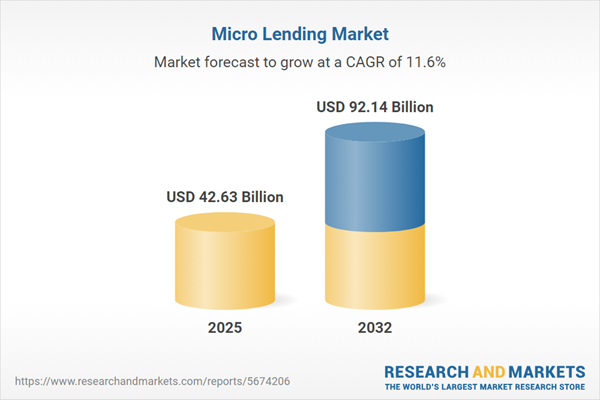Speak directly to the analyst to clarify any post sales queries you may have.
The micro lending market is transforming how capital reaches underserved segments, driven by digital innovation, evolving consumer needs, and regulatory developments. This analysis provides decision-makers with actionable insights to navigate current shifts and build resilient business strategies.
Market Snapshot: Micro Lending Market Size and Growth
The global micro lending market grew from USD 38.22 billion in 2024 to USD 42.63 billion in 2025 and is projected to expand at a CAGR of 11.62%, reaching USD 92.14 billion by 2032. Technology-driven changes, regulatory shifts, and rising financial inclusion initiatives underpin sustained momentum across all key regions.
Scope & Segmentation: Comprehensive Industry Coverage
- Provider Types: Bank lenders, cooperative lenders, microfinance institutes, nonbank financial companies (NBFCs).
- Distribution Channels: Assisted service (including agent and field officer assisted), branch channels, digital platforms (mobile apps, web portals), point-of-sale channels.
- Lending Models: Group lending, individual lending.
- Borrower Categories: Men, women, youth borrowers (student and non-student).
- End Uses: Agricultural purposes (crop production, livestock), housing finance, micro enterprise (manufacturing, retail, service), personal funding.
- Loan Sizes: Large loans, medium loans, small loans, very small loans.
- Regional Coverage: Americas (including North America and Latin America), Europe, Middle East & Africa, Asia-Pacific (including major economies across all regions).
- Key Participants: Leading fintechs, microfinance players, banks, NBFCs, and global technology vendors.
Key Takeaways for Senior Decision-Makers
- Technological advancement is reshaping credit assessment, with artificial intelligence and alternative data enabling faster, more accurate underwriting processes and enhancing borrower reach.
- Digital and agent-assisted delivery models are bridging last-mile gaps, enhancing inclusion for rural and remote segments and providing both speed and human trust.
- Fintech platforms and collaborative ventures are driving new lending products tailored to the operational realities of agricultural, microenterprise, and housing markets.
- Segment-specific strategies—addressing gender, age, and loan use—are essential for lenders pursuing diversified, sustainable portfolios.
- The rapid evolution of regional frameworks emphasizes the need for context-driven go-to-market strategies and responsive compliance functions.
- Competitive advantage increasingly relies on the integration of environmental, social, and governance (ESG) metrics in lending decisions and portfolio reporting.
Tariff Impact: Navigating Supply Chain & Cost Pressures
The introduction of new US tariffs in 2025 heightened cost pressures for micro lending institutions reliant on imported technology and financial infrastructure. These increases have necessitated realignment of supplier networks and accelerated the adoption of domestic or modular technology solutions. Digital platform providers have faced delays in deploying new features due to higher expenses for IT infrastructure. As a result, certain lenders have revised interest rate structures to manage operational viability, with proactive participants leveraging local partnerships, onshore IT, and cross-border collaborations to sustain growth and mitigate disruptions.
Methodology & Data Sources
Our analysis is based on a multi-layered methodology, integrating executive interviews, borrower focus groups, and field data collection from diverse markets. Thorough review of regulatory documents, industry reports, and financial statements complemented primary data. Findings underwent expert panel validation and the Delphi technique to ensure reliability and consensus.
Why This Report Matters
- Delivers intelligence on evolving borrower behavior, competitive moves, and policy trends, enabling your teams to anticipate shifts and respond with agility.
- Clarifies the impact of regional and segment trends on operational planning, helping to inform product, partnership, and risk management strategies.
- Provides a practical guide for investment, compliance, and technology integration across fast-changing micro lending landscapes.
Conclusion
A dynamic blend of innovation, regulatory alignment, and targeted delivery models is shaping the next era of micro lending. Understanding these changes allows organizations to build competitive, responsive strategies. Senior leaders equipped with these insights are positioned to drive market success in a rapidly evolving environment.
Additional Product Information:
- Purchase of this report includes 1 year online access with quarterly updates.
- This report can be updated on request. Please contact our Customer Experience team using the Ask a Question widget on our website.
Table of Contents
3. Executive Summary
4. Market Overview
7. Cumulative Impact of Artificial Intelligence 2025
Companies Mentioned
The companies profiled in this Micro Lending market report include:- Ant Group Co., Ltd.
- CreditEase Holdings Co., Ltd.
- Banco Compartamos, S.A.
- Bandhan Bank Limited
- Bharat Financial Inclusion Limited
- FINCA Microfinance Holdings, Ltd.
- ASA International plc
- Equitas Small Finance Bank Limited
- Ujjivan Financial Services Limited
- Jana Small Finance Bank Limited
Table Information
| Report Attribute | Details |
|---|---|
| No. of Pages | 192 |
| Published | November 2025 |
| Forecast Period | 2025 - 2032 |
| Estimated Market Value ( USD | $ 42.63 Billion |
| Forecasted Market Value ( USD | $ 92.14 Billion |
| Compound Annual Growth Rate | 11.6% |
| Regions Covered | Global |
| No. of Companies Mentioned | 11 |









